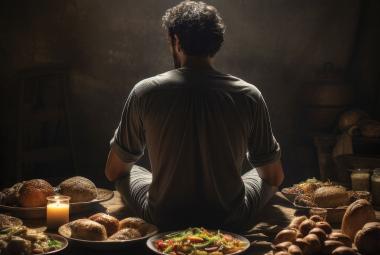In the last article, we continued our exploration of the architecture of Solomon's Temple. Using the Scripture, "...ye are the Temple of God" (1 Corinthians 3:16), we compared each of the rooms and features of Solomon's Temple to our own internal design - our spirit, heart, will, soul and body.
I would like to further our investigation of Solomon's Temple over the next few months by concentrating on the secret, hidden chambers (cheder). Let's try to understand, a little more clearly, how these secret recesses correspond to the hidden place in our own internal design.
This is a very controversial subject, as many Christians do not believe that we have a hidden part - a place where we hide and bury our hurts, wounds, painful memories, etc. So, be as the Bereans, check everything out.
I believe, however, a very important part of renewing our minds is the cleansing, healing and filling of these hidden chambers. Proverbs 24:3-4 tells us, "...by [intimate] knowledge shall the chambers (cheder) be filled with all precious and pleasant riches." This is why I would like to spend some time, first of all understanding these secret places and then understanding how we are to put off the hidden things, so that we can put on Christ, even here. Truly, "a people who do not understand will fall." (Hosea 4:14)
We shared last month how CHART 12 is God's "ideal" for us. It's His Will that we constantly be filled with the Spirit." "Be not unwise, but understand what the will of God is...be filled with the Spirit." (Ephesians 5:17-18) If we are believers, then, we already possess God's Life in our hearts (7). Our job is simply to make sure that it's God's Life that is showing forth in our souls.
This does not automatically happen, however. See (CHART 13). When we make emotional choices, God's Life - His Light - in our hearts, gets covered and quenched. CHART 13 then is the result. As you can see, the soul life that is produced here is not God's Life at all, but our very own "self life" - our own thoughts, emotions and desires that are contrary to Gods.
Let me ask you a question. If we are born again and we have God's Life in our new hearts (7), and this now is our "true nature" (Christ in us), where does our "self-life" (10) come from? Where is it originated from?
You check me out, but I believe one of the ways that our "self-life" is triggered is by the hurts, resentments, doubts, pride, bitterness, etc., that we have never properly dealt with before (either out of ignorance or disobedience) but have simply stuffed and buried in the secret, hidden chambers of our souls (6) thinking "no one will see, no one will know." I believe self-life is triggered when we choose to follow what these "buried" things are prompting us to do, over what God has told us to do.
Self-life (or, if you prefer, "the flesh") is simply "residual life," which means part of the original has remained even after another part has been taken away. When we became born again, we received a brand new spirit, a new heart and a new supernatural willpower (the white on the charts), but our soul and body (the gray area on the charts) remained the same. It was redeemed (bought by the Blood of the Lamb), but it was not changed or renewed.
This is the "sanctification" process that we are all going through now where God is trying to teach each of us how to set aside our self-life (our flesh) so that His Life from our hearts can come forth giving us that intimate knowledge of God (the 6th function of the Mind of Christ - knowing His Life in place of our own) which we all so desperately want.
To show you how this works, let's review CHART 10. Notice that in the Temple of Solomon, the Holy of Holies (A), the Holy Place (B), and the Porch (C) were all rooms that had solid gold walls and solid gold furniture (white on the chart). What does gold symbolize? It symbolizes purity and holiness. I believe it symbolizes God's new imparted nature that each of us have been given as a result of our new birth.
Notice, however, the Pillars (D), the Inner Court (H) and the Outer Court (I) are all gray on the charts - which is supposed to signify that these rooms had bronze structures and furnishings. Bronze is symbolic of something that must still be judged. It means that sin is present in these areas. Bronze indicates something that is not yet totally renewed. It's redeemed, but not yet renewed.
The secret hidden chambers (E), that we are about to study, are also gray on the charts, but were actually made of wood, which symbolizes "humanity." The root of the Hebrew word for wood means "something to be burned up." This is interesting because that's exactly what God would have us do with most of the "debris" that we have stuffed and stored in this area. I believe the Temple model validates that, at our new birth, we are given a new supernatural spirit (1), a new supernatural heart (2) and a new supernatural willpower (3), but the gray area - our soul (4) and our body (5) - is not yet changed, renewed or sanctified.
The Hidden Chambers
Now let's focus on the secret, hidden chambers. Turn to CHART 14.1
1. Ground Plan;
2. Side View;
3. Longitudinal cross-section;
4. Breadth cross-section;
5. Front view.
This is again a floor plan of Solomon's Temple. The hidden chambers, as you can see, were built all around the outside of the sanctuary. These chambers belonged to the original floor plan of the Temple that God gave to David in 1 Chronicles 28:11-12.
Notice in illustration #1 that these chambers had no access (no doors) into them, either from the Holy of Holies, the Holy Place or the Porch. This will be important later. The only entrance to and from these secret recesses was by one door in the very front of the sanctuary building. (See illustration #5.)
1 Kings 6:5-8 tells us that there were three levels of these tiered chambers - 31 hidden cubicles on each level. (See illustration #4.) Since the walls around the main sanctuary were three feet thick, these chambers simply rested on ledges (or brackets) so they were not actually built or secured into the walls.
As we said in our last article, these secret recesses were supposed to be used for storing the priests' items of worship used in the Holy Place and also, where the priests were to display Israel's treasures to remind the people of all that God had done for them. It was here, however, that the priests actually stored their own personal idolatrous worship items, thinking that since these were secret, hidden places, no one would see and no one would know.
One of the comments made to me recently, by someone who does not believe we have a hidden place within us, (he believes we are "aware" of everything we think and feel) was, "Wouldn't these priests know exactly what they had stored in these hidden recesses? Wouldn't they be aware of everything that was in there?" I answered him by saying, "They would probably be aware of some of the things they had stored in there. But, like my own attic in my house, I'm certainly not aware of everything that I have put in there over the years." Are you? I think it was the same for these priests. They were aware of some of the things that were hidden there, but certainly not all of the items - they were secret and hidden, even to them.
Our Hidden Place
I believe these secret, hidden, storage chambers of Solomon's Temple correspond to our own innermost part, our own secret place - the place in our soul where we store, hide and bury our wounds, hurts, guilt and memories (either out of ignorance or disobedience) - thinking no one will see, no one will know. These are things that are just too painful to retain in our consciousness, so we push them down and try to forget about them.
In Scripture, these Temple hidden recesses are called in the Hebrew, cheder. Cheder means "innermost part," the secret place or the hidden chambers. Now, there is no mention of the word "subconscious" in Scripture, so to be completely Scriptural (and not stumble anyone), we must call this area cheder.
Here are a few provocative Scriptures that refer to our "cheder":
Proverbs 20:27, "the spirit of man is the candle of the Lord, searching all the inward parts (cheder) of the belly." Why would the spirit search our inward parts if not to reveal sin in us, to us?
Proverbs 18:8, "The words of a talebearer are as wounds, and they go down into the innermost parts (cheder) of the belly." This, to me, is very graphic, because we all know what it's like to hear that someone has gossiped about us. If we don't deal with that hurt right away, it can easily become a "root of bitterness." Now, if there is no secret place or hidden chambers, what is this Scripture talking about? This is also quoted in Proverbs 26:22.
And then, there's Proverbs 24:4 which we read earlier, "by knowledge [intimate] shall the chambers (cheder) be filled with all precious and pleasant riches." God wants to empty out the hidden chambers of all the debris, and then fill them back up with His Truth.
Of the 38 Scriptures that use the word cheder in the Bible, over half of them refer to a secret, hidden, innermost chamber or parlor.
Now see CHART 15 . Access to and from these hidden chambers came through only one door at the front of the Temple sanctuary. So too, I believe, the "power of sin" (23) which resides in our bodies, has access not only to the conscious part of our soul (our self-life) (19), but also has access to these secret, hidden recesses of our souls (6). Remember, the hidden chambers are a part of our flesh.
(Now, it's very important to note that neither Satan nor the power of sin have access to our new spirit, our new heart or our new willpower. These areas are inviolate. Just as in the Temple of Solomon, there was no outside access to the Holy of Holies, the Holy Place and the Vestibule of the Porch, so too, our spirit, heart and willpower are inaccessible to outside influences.)
However, just like in Solomon's Temple, there was free access to the Inner and Outer Courts, so too, we give the enemy access to our soul and body (the gray area), when we make emotional choices (review CHART 13). This is where the "walls of our souls" give way.
The Power of Sin
One of the reasons we are so prone to making self-centered, emotional choices, is that our souls (4) and our bodies (5) (i.e., the flesh) are still dominated and controlled by the "power of sin" (23). The power of sin is the energy force that Paul tells us in Romans 7:20-21, 23, dwells in our unrenewed bodies.
The power of sin's whole intent and purpose is to cause us to "veer off course" and to "miss the mark" The "mark" refers to Romans 8:29, being conformed into the image of Christ.
Satan uses the power of sin as his tool to gain access to our flesh (all the gray area on the charts). Now, no one can take us out of the keeping power of God once we have been born again (our new spirit, heart and supernatural willpower), but we can, by our continual free choice, quench God's Power in us and open our souls and bodies up to the power of sin.
And, because of our ignorance as to how we renew our minds, what the Mind of Christ is, and the power and authority of God we possess because of it, Satan has been having a "hey day" keeping us his prisoners.
Satan's goal, through the power of sin, is to work hand in hand with our flesh, trying to influence, persuade and manipulate us to go by our own self-life, rather than obey and trust God to perform His Will in our lives.
The enemy wants us to be conformed to the world's image (CHART 13), because then the Gospel will not be passed on.
God, on the other hand, wants us to constantly yield our self-life to Him, regardless of how we feel or what we think, and put on the Mind of Christ. Then, we'll be conformed to Christ's Image (CHART 12) and the Gospel will have a chance to be passed on.
"I am crucified with Christ; nevertheless I live; yet not I, but Christ liveth in me; and the life which I now live in the flesh I live by the faith of the Son of God, Who loved me and gave Himself for me."
To be continued in the next article, 'The Hidden Chambers'. This article has been excerpted from Chuck and Nan's new and expanded Be Ye Transformed textbook (now in its second printing).
Notes:
- Vincent-Steve, Jerusalem de l'Ancien Testament, J. Gabalda & Cie., Paris 1956, tome 11.




